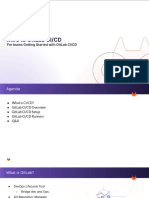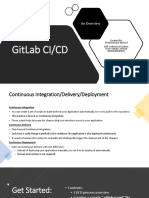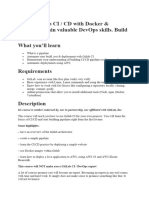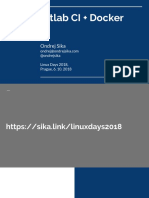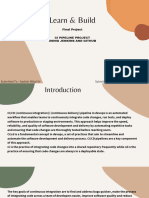Understanding Gitlab Pipelines - Creating CI/CD Flow https://nexocode.com/blog/posts/understanding-principles-of-gitlab-ci-c...
WEB APPLICATIONS
Understanding Gitlab
Pipelines - Creating
CI/CD Flow
WOJCIECH MARUSARZ -
NOVEMBER 17, 2021
Inside this article:
1. CI/CD (Continuous Integration/Continuous Delivery)
2. Gitlab Pipelines Explained
3. Gitlab Runner Step by Step
4. Artifacts and Cache Operations
5. Gitlab CI/CD Is for Humans
1 of 31 12/31/2023, 8:45 PM
Understanding Gitlab Pipelines - Creating CI/CD Flow https://nexocode.com/blog/posts/understanding-principles-of-gitlab-ci-c...
CI and CD are concepts that have been around for a
long time, but the speci�cs of implementing them often
can be murky. Continuous integration and delivery are
critical components of modern software development,
and GitLab has some fantastic features for creating
pipelines. Gitlab documentation is excellent, but when
I learn, I need an understanding of fundamental
principles - it allows me to build knowledge upon it.
This article will cover what GitLab CI/CD pipelines do
and look at some of the best practices you should keep
in mind when setting up your own continuous
integration or delivery pipeline.
The project is agnostic when it comes to the language
or technology used in the project so that anyone can
read it.
CI/CD (Continuous
Integration/Continuous
Delivery)
It is impossible to create a CI/CD pipeline on our local
machine.
Continuous integration won’t work because everything
would have to be integrated by you, whenever you
decide to pull changes from the remote repository and
2 of 31 12/31/2023, 8:45 PM
Understanding Gitlab Pipelines - Creating CI/CD Flow https://nexocode.com/blog/posts/understanding-principles-of-gitlab-ci-c...
trigger validating commands, e.g., running unit tests.
Stories on software
engineering straight to your
inbox
SIGN UP FOR NEWSLETTER �
Continuous deployment also won’t work because you
will have to trigger all deployment tasks manually,
which is very risky. After all, the environment where
you run commands may change during the time, and
build results may di�er.
It would be best if you simply had some environment
that is predictable and where all jobs can be done.
Yes, it is GitLab.
Gitlab is a DevOps platform. It is not just a git
repository but also a set of tools that allows you to run
unit tests, execute a build job, deploy an application,
3 of 31 12/31/2023, 8:45 PM
Understanding Gitlab Pipelines - Creating CI/CD Flow https://nexocode.com/blog/posts/understanding-principles-of-gitlab-ci-c...
and many, many more. In short words, it will enable
you to con�gure CI/CD pipelines.
Since it is a web application, it may be accessed by
any team member, which allows fruitful collaboration,
which is necessary for the software development
lifecycle.
To de�ne CI/CD pipeline, you need to create in your
repository a .gitlab-ci.yml �le located in the root
directory of the project that illustrates pipeline
con�guration, including jobs and pipeline stages. It is a
yml �le, which GitLab interprets.
The pipeline consists of stages and jobs. As the name
suggests, a job is a particular job to do, e.g., building
your application. Jobs that can run at the same time
are grouped into the same stage. Look at the example
pipeline. There are four stages: Test stage, Build stage,
Image stage, and Deploy stage. Each of them runs its
own tasks, ex. Test contains jobs: Test API and Test UI.
Example of a ci/cd pipeline
4 of 31 12/31/2023, 8:45 PM
Understanding Gitlab Pipelines - Creating CI/CD Flow https://nexocode.com/blog/posts/understanding-principles-of-gitlab-ci-c...
More on CI/CD pipelines here:
https://docs.gitlab.com/ee/ci/introduction/#gitlab-
cicd-work�ow
Gitlab Pipelines Explained
Jobs in pipelines depend on each other. A pipeline job
may require some input, produce some output, use a
cache, and need some con�guration.
Suppose you want to run pipelines on your own. In that
case, you need a better understanding of artifacts and
cache, which allows jobs to share data between jobs,
as well as environment variables that will enable jobs
to work according to provided con�guration.
Artifacts
To deploy an application, you probably need docker
images. To create docker images, you need to build
your application. To build your application, you have
to be sure that unit tests pass, etc.
If you preview the dependency graph for any GitLab
project, you may notice that jobs depend on each
other. De�ning such dependencies is required because
a single job doesn’t do the whole job on its own.
5 of 31 12/31/2023, 8:45 PM
Understanding Gitlab Pipelines - Creating CI/CD Flow https://nexocode.com/blog/posts/understanding-principles-of-gitlab-ci-c...
Dependencies between jobs
Job needs some input from a previous job and
produces some output for consecutive jobs. - this data,
which is passed between jobs, is called an artifact.
Using artifacts allows a job to prepare a small portion
of data, archive it and pass it to another job. Thanks to
that, jobs have low complexity because they are
responsible only for a single thing.
More on artifacts here: https://docs.gitlab.com/ee/ci
/pipelines/job_artifacts.html
Cache
For optimization purposes, you may use cache. The
cache is excellent for downloading external
dependencies like 3rd-party libraries.
If your list of dependencies has not changed, there is
no need to download dependencies for each test run
or build. In contrast to artifacts, the cache is shared
between pipelines. More on caching here:
https://docs.gitlab.com/ee/ci/caching/
6 of 31 12/31/2023, 8:45 PM
Understanding Gitlab Pipelines - Creating CI/CD Flow https://nexocode.com/blog/posts/understanding-principles-of-gitlab-ci-c...
CI/CD Variables
The repository is accessed by all team members, so
not everything should be stored there, I mean secrets
ex.: credentials, connections strings, etc.
To protect such sensitive data, in GitLab, you can
de�ne environment variables that may be accessed
only by project maintainers. Variables may be
accessed in the .gitlab-ci.yml �le using the variable
key, without exposing its value.
Additionally, you may also want to use information
about your build environment, e.g., allow running
deploy jobs only on the main branch, etc. To do so, you
can use some prede�ned variables.
Gitlab CI/CD variables are a great solution that allows
you to customize your CI/CD pipelines and protect
your secrets.
More details on CI/CD variables:
https://docs.gitlab.com/ee/ci/variables/
How Does Gitlab Do Its Job?
At �rst glance, GitLab pipelines may look like a black
box, but it is a little less scary if you understand how it
uses Artifacts, Cache, and CI/CD.
7 of 31 12/31/2023, 8:45 PM
Understanding Gitlab Pipelines - Creating CI/CD Flow https://nexocode.com/blog/posts/understanding-principles-of-gitlab-ci-c...
Probably you know how to compile, run tests or build
your project on a local machine. You also know how to
build and run docker images on your machine.
How is it possible that a web application like Gitlab
executes such a tremendous job?
The response is Gitlab Runners & Gitlab Executors.
How Does Gitlab Runner Work?
8 of 31 12/31/2023, 8:45 PM
Understanding Gitlab Pipelines - Creating CI/CD Flow https://nexocode.com/blog/posts/understanding-principles-of-gitlab-ci-c...
CHECK THIS SERIES �
Gitlab Runner is an open-sourced service written in Go
that is responsible for running your pipeline. It
9 of 31 12/31/2023, 8:45 PM
Understanding Gitlab Pipelines - Creating CI/CD Flow https://nexocode.com/blog/posts/understanding-principles-of-gitlab-ci-c...
communicates with Gitlab and delegates jobs to
executors.
Each runner, when it becomes available, sends
requests to the GitLab instance, asking to be assigned
jobs.
GitLab, when asked, is responsible for dividing work
between runners. Still, most of the e�ort is done by
runners and executors, which is good because it allows
sharing the workload between multiple servers.
Interesting fact. In the beginning, runners were written
in Ruby, which requires Ruby with its dependencies. It
was heavy.
In 2015 Kamil Trzciński created his own runner written
in Go as a side task, which is great for multi-tasking
and parallelization. GitLab noticed this brilliant
solution, and right now, it is a default runner used by
Gitlab. You can learn more about it from Kamil’s
presentation on Youtube. Kamil works for GitLab now.
Are GitLab Runners Safe?
As a default, you may want to use shared runners
provided by GitLab. You may be afraid that using
runners installed on servers managed by GitLab may
10 of 31 12/31/2023, 8:45 PM
Understanding Gitlab Pipelines - Creating CI/CD Flow https://nexocode.com/blog/posts/understanding-principles-of-gitlab-ci-c...
be risky because your source code may leak. This is a
reasonable concern.
But, instead of using shared runners, you can use your
own runners installed on your machine. It is a better
solution due to performance and security reasons.
You can register several runners and use them the
whole time without usage limitations de�ned by
GitLab, which right now is 400 minutes in the free tier.
It means that you can collaborate with your team
members without any unwanted interruptions, which is
necessary for continuous integration.
For beginners, I recommend using your own GitLab
runner installed as a docker container because it is
great for fast prototyping.
What is also essential, Gitlab CI/CD runs on the
machines of your choice. This means that the whole
source code is downloaded to the machine managed
by you. For sure, runners managed by GitLab are
secure, but still - you never know.
What Are Gitlab Executors?
An executor is a service that receives assignments
from the runner and executes jobs de�ned in .gitlab-
11 of 31 12/31/2023, 8:45 PM
Understanding Gitlab Pipelines - Creating CI/CD Flow https://nexocode.com/blog/posts/understanding-principles-of-gitlab-ci-c...
ci.yml. Several types of executors allow you to select
an environment where the job is executed. The
simplest one is shell executor, which uses a shell on the
machine where the runner is installed - it means that it
may be your laptop. Unfortunately, shell executor does
not guarantee a clean environment for each job and
requires manual installation of the necessary software.
I recommend using the docker executor for beginners,
which guarantees a new environment for each
pipeline run. Decision upon executor may be done
when registering your runner in GitLab.
Gitlab Runner Execution Flow
Let’s see how runners and executors collaborate with
Gitlab, looking at GitLab runner execution �ow. This
is how an entire pipeline is executed.
12 of 31 12/31/2023, 8:45 PM
Understanding Gitlab Pipelines - Creating CI/CD Flow https://nexocode.com/blog/posts/understanding-principles-of-gitlab-ci-c...
Gitlab runner execution �ow
First of all, GitLab must be aware that such an executor
exists, and for security reasons, must be sure that it is a
runner managed by the owner of the repository. To
gain access to the repository, the runner must be
registered using the token provided by GitLab. It is a
pretty straightforward process. As I already
mentioned, I recommend using GitLab runner
installed in a container.
Then the runner is asking for jobs to execute. If there is
13 of 31 12/31/2023, 8:45 PM
Understanding Gitlab Pipelines - Creating CI/CD Flow https://nexocode.com/blog/posts/understanding-principles-of-gitlab-ci-c...
something to do, the runner downloads job details and
triggers an executor. Executor clones the git
repository, downloads artifacts, and executes jobs
de�ned in .gitlab-ci.yml.
When an executor is done, it uploads job output and
job status to GitLab.
GitLab Pipeline Jobs
To better understand GitLab runners, let’s see the
example GitLab repository, with pipelines and jobs
de�ned in .gitlab-ci.yml. The pipeline consists of four
jobs as follows: update artifact, update cache, update
C&A, and check, which veri�es the �nal status of the
pipeline.
Example pipeline jobs
Each job executes the same commands, which display
the content of the working directory and show the
content of cache and artifact �les.
- ls # show all files and directories in working directory
- if test -f ./cache-file; then cat ./cache-file; fi;
14 of 31 12/31/2023, 8:45 PM
Understanding Gitlab Pipelines - Creating CI/CD Flow https://nexocode.com/blog/posts/understanding-principles-of-gitlab-ci-c...
- if test -f ./artifact-file; then cat ./artifact-file;
For the sake of simplicity, I use only one �le as cache
and one �le as an artifact, but you can also de�ne a
whole directory. Additionally, jobs have their
responsibilities: Job update artifact adds some text to
artifact-�le
- echo "artifact updated in job 1A, secret [$SECRET_KEY
Job update cache also adds some text, but to cache-
�le
- echo "cache created in job 1B, secret [$SECRET_KEY], on bra
Job update C&A updates both cache and artifact:
- echo "update artifact in job 2A, secret [$SECRET_KEY
- echo "update cache in job 2A, secret [$SECRET_KEY], on bran
Note usage of prede�ned variable
CI_COMMIT_BRANCH and environment variable
SECRET_KEY de�ned in repository CI/CD settings
below. Variables will be injected into docker
containers when the pipeline runs.
15 of 31 12/31/2023, 8:45 PM
Understanding Gitlab Pipelines - Creating CI/CD Flow https://nexocode.com/blog/posts/understanding-principles-of-gitlab-ci-c...
GitLab Environment Variables
That’s basically it. As you can see, jobs are
straightforward, the only responsibility of the job is to
create or update �les, but it is excellent for further
explanation.
You can say that this is not a practical application for
GitLab pipelines, but that’s what most of the pipelines
do in real projects. Based on source code, build �les
are created - it may be a jar �le, dist directory, or
docker image, but still, it is only a set of �les.
Gitlab Runner Step by Step
Gitlab runner may run multiple jobs de�ned in gitlab-
ci.yml. Let’s see how the speci�c runner operates,
looking at the very �rst job executed in the pipeline. In
job logs, you can �nd several exciting entries.
Download a docker image inside which the whole job
is executed - in this case, it is a very lightweight Linux
instance called alpine.
16 of 31 12/31/2023, 8:45 PM
Understanding Gitlab Pipelines - Creating CI/CD Flow https://nexocode.com/blog/posts/understanding-principles-of-gitlab-ci-c...
Using Docker executor with image alpine ...
Pulling docker image alpine ...
Clone the git repository and mount it inside the docker
container.
Getting source from Git repository
Created fresh repository.
Checking out 0e585cb3 as main…
Restore cache based on the key, which is calculated
based on �le cache-key in the repository. In real-life
projects, cache keys could be calculated on
build.gradle or package.json. As default, the cache is
stored where GitLab Runner is installed - so there is no
need to download cache from any external server.
Checking cache for 1069cd7938a4180b9c6b962f6476ed257d5c2a35..
Successfully extracted cache
Note that there is no need to download job artifacts
because job artifacts are accessible within the same
pipeline, on the machine where Gitlab Runner is
installed and where each job is executed.
Execute shell script de�ned in yml �le.
17 of 31 12/31/2023, 8:45 PM
Understanding Gitlab Pipelines - Creating CI/CD Flow https://nexocode.com/blog/posts/understanding-principles-of-gitlab-ci-c...
Execute job defined in gitlab-ci.yml
Executing "step_script" stage of the job script
Using docker image sha256:14119a... for alpine
After the job is done, preserve the updated cache for
future use.
Saving cache for successful job
Creating cache a9406f87e1a5d81018be360ad0ca2f3f0b38fa37...
No URL provided, cache will be not uploaded to shared
After the job is done, upload job artifacts to make
them available on Gitlab UI.
Uploading artifacts...
./artifact-file: found 1 matching files and directories
Uploading artifacts as "archive" to coordinator...
That’s basically it. If the exit code is zero, it means that
the job succeeded.
Cleaning up project directory and file based variables
Job succeeded
Artifacts and Cache
Operations
18 of 31 12/31/2023, 8:45 PM
Understanding Gitlab Pipelines - Creating CI/CD Flow https://nexocode.com/blog/posts/understanding-principles-of-gitlab-ci-c...
Let’s see how artifacts and cache �les (that are not
under source control) are used by GitLab pipelines
based on the example below.
There are three pipelines in this repository, which are
started on the same main branch.
Executed GitLab pipelines
First Pipeline
First pipeline started with a fresh environment
The �rst pipeline is the �rst one that is started in the
repository, with a brand new environment.
Let’s see the output of the very �rst run of the update
artifacts job. The same situation is for the very �rst run
of the update cache job.
19 of 31 12/31/2023, 8:45 PM
Understanding Gitlab Pipelines - Creating CI/CD Flow https://nexocode.com/blog/posts/understanding-principles-of-gitlab-ci-c...
$ ls
README.md
cache-key
$ if test -f ./cache-file; then cat ./cache-file; fi;
$ if test -f ./artifact-file; then cat ./artifact-file;
$ echo "artifact updated in job 1A, secret [$SECRET_KEY
As you can see, there are only two �les in the working
directory - these are �les from the repository -
*README.md *and cache-key. There is no cache-�le
nor artifact-�le.
A di�erent situation is for the consecutive job: update
C&A.
$ ls
README.md
artifact-file
cache-file
cache-key
$ if test -f ./cache-file; then cat ./cache-file; fi;
cache created in job 1B, secret [secret_value], on branch [ma
$ if test -f ./artifact-file; then cat ./artifact-file;
artifact updated in job 1A, secret [secret_value], on branch
As you can see, there are two additional �les:
• artifact-�le with content artifact updated in job 1A,
20 of 31 12/31/2023, 8:45 PM
Understanding Gitlab Pipelines - Creating CI/CD Flow https://nexocode.com/blog/posts/understanding-principles-of-gitlab-ci-c...
secret [secret_value], on branch [main]
• cache-�le with content cache created in job 1B,
secret [secret_value], on branch [main]
It means that both cache and artifact �les are
accessible for consecutive jobs in the pipeline.
Second Pipeline
A second pipeline has access only to cache �les. Look
at the output for the �rst job in the second pipeline -
update artifacts:
$ ls
README.md
cache-file
cache-key
$ if test -f ./cache-file; then cat ./cache-file; fi;
cache created in job 1B, secret [secret_value], on branch [ma
update cache in job 2A, secret [&SECRET_KEY], on branch [main
$ if test -f ./artifact-file; then cat ./artifact-file;
There is only a cache-�le available. It means that
cache is shared between pipelines, but artifacts don’t.
Third Pipeline
After the second pipeline �nished, the �le cache-key
21 of 31 12/31/2023, 8:45 PM
Understanding Gitlab Pipelines - Creating CI/CD Flow https://nexocode.com/blog/posts/understanding-principles-of-gitlab-ci-c...
was updated. It means that the cache was invalidated
and couldn’t be used anymore.
Let’s see at the third pipeline. After the cache-key
update, job update artifacts didn’t have access to the
outdated cache, as you can see below
$ ls
README.md
cache-key
$ if test -f ./cache-file; then cat ./cache-file; fi;
$ if test -f ./artifact-file; then cat ./artifact-file;
There were only two �les in the working directory, as
at the beginning.
Gitlab CI/CD Is for Humans
Getting acquainted with GitLab runner execution �ow
allowed me to understand that running pipelines on
GitLab is just running the same command that I could
run on my local machine.
The main di�erence is that Gitlab pipelines allow
collaboration and provide a clean environment for
each build because docker images may be used. An
environment that ensures repeatability is the essential
requirement of the software development lifecycle
22 of 31 12/31/2023, 8:45 PM
Understanding Gitlab Pipelines - Creating CI/CD Flow https://nexocode.com/blog/posts/understanding-principles-of-gitlab-ci-c...
with CI/CD con�gured.
Thanks to artifacts and cache, results of commands
may be accessed for consecutive jobs and allow
caching to prevent downloading the same data all the
time.
If you understand the basic concepts of GitLab
pipelines, feel free to clone this repository and run
some experiments on your new CI/CD project. You can
run some jobs only on a speci�c branch; you can open
merge requests and run jobs after merging. You could
detect code changes and run some jobs if there were
changes in particular directories.
References
https://docs.gitlab.com/ee/ci
https://docs.gitlab.com/runner
https://docs.gitlab.com/runner/executors
https://docs.gitlab.com/ee/ci/introduction/#gitlab-
cicd-work�ow
https://www.digitalocean.com/community/tutorials
/how-to-set-up-a-continuous-deployment-pipeline-
with-gitlab-ci-cd-on-ubuntu-18-04
23 of 31 12/31/2023, 8:45 PM
Understanding Gitlab Pipelines - Creating CI/CD Flow https://nexocode.com/blog/posts/understanding-principles-of-gitlab-ci-c...
https://medium.com/@ryzmen/gitlab-fast-
pipelines-stages-jobs-c51c829b9aa1
https://www.section.io/engineering-education
/building-a-cicd-pipeline-using-gitlab
About the author
24 of 31 12/31/2023, 8:45 PM
Understanding Gitlab Pipelines - Creating CI/CD Flow https://nexocode.com/blog/posts/understanding-principles-of-gitlab-ci-c...
Wojciech Marusarz
Software Engineer
Wojciech enjoys working with small teams where the
quality of the code and the project's direction are essential.
In the long run, this allows him to have a broad
understanding of the subject, develop personally and look
for challenges. He deals with programming in Java and
Kotlin. Additionally, Wojciech is interested in Big Data tools,
making him a perfect candidate for various Data-Intensive
Application implementations.
Tempted to work
on something
as creative?
25 of 31 12/31/2023, 8:45 PM
Understanding Gitlab Pipelines - Creating CI/CD Flow https://nexocode.com/blog/posts/understanding-principles-of-gitlab-ci-c...
That’s all we do.
JOIN NEXOCODE �
26 of 31 12/31/2023, 8:45 PM
Understanding Gitlab Pipelines - Creating CI/CD Flow https://nexocode.com/blog/posts/understanding-principles-of-gitlab-ci-c...
Want to be a part of our
This article is a part of
27 of 31 12/31/2023, 8:45 PM
Understanding Gitlab Pipelines - Creating CI/CD Flow https://nexocode.com/blog/posts/understanding-principles-of-gitlab-ci-c...
3 6 ART ICLES
Zero Legacy
What goes on behind the scenes in our engineering
team? How do we solve large-scale technical
challenges? How do we ensure our applications
run smoothly? How do we perform testing and
strive for clean code?
Follow our article series to get insight into our
developers' current work and learn from their
experience. Expect to see technical details,
architecture discussions, reviews on libraries and
tools we use, best practices on software quality,
and maybe even some fail stories.
CHECK IT OUT �
28 of 31 12/31/2023, 8:45 PM
Understanding Gitlab Pipelines - Creating CI/CD Flow https://nexocode.com/blog/posts/understanding-principles-of-gitlab-ci-c...
Zero Legacy
Insights from nexocode team just one click
away
Sign up for our newsletter and don't miss out on the
updates from our team on engineering and teal culture.
First Name
Last Name
Your Email
I agree to the information on data processing, privacy policy and
newsletter rules described here.
I agree to receive marketing communication from nexocode.
SIGN UP FOR NEWSLETTER �
Transform your business
29 of 31 12/31/2023, 8:45 PM
Understanding Gitlab Pipelines - Creating CI/CD Flow https://nexocode.com/blog/posts/understanding-principles-of-gitlab-ci-c...
with AI
Subscribe to our newsletter
Leave your email. We'll reach out!
�
I agree to the information on data processing, privacy policy and newsletter
rules.
I agree to receive marketing communication from nexocode.
Follow us
SERVICES
AI Design Sprint
AI Consulting Services
Cloud Development Services
Data Engineering Services
SOLUTIONS
Computer Vision
Natural Language Processing
Predictive Analytics
Recommendation Systems
Dynamic Pricing Services
30 of 31 12/31/2023, 8:45 PM
Understanding Gitlab Pipelines - Creating CI/CD Flow https://nexocode.com/blog/posts/understanding-principles-of-gitlab-ci-c...
Data Strategy Bootcamp
RESOURCES
AI Design Sprint
The Art of Buliding an AI-Driven Company
INDUSTRIES
AI in Logistics
AI in Pharma
COMPANY
About us
Blog
Careers
Case Studies
Contact
nexocode
ul. Wadowicka 7
30-347 Kraków, Poland
Copyright 2023 © Nexocode | Privacy policy | RSS
31 of 31 12/31/2023, 8:45 PM






















